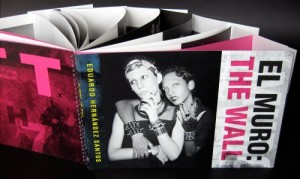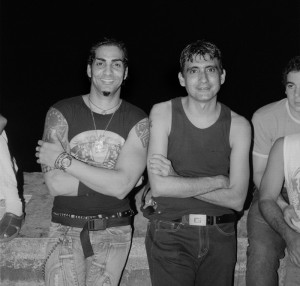What’s the point of looking fabulous if nobody gets to see you? Even in Castro’s blatantly repressive Cuba, the ever-resilient LGBT community has taken to the streets, or rather the wall, El Malecon. The five-mile promenade and sea wall, extending along the coast from Old to Central Havana, draws hundreds of Habaneros every night to chat, flirt, and relax in the cool evening breeze.
Keep in mind that, due to Cuba’s aging and deteriorated power grid, Havana at night is deliciously dark. So El Malecon also serves as ground zero for horny heterosexual couples, a long-standing, and socially acceptable place to escape the confines of cramped apartments and their family’s prying eyes.
One short block of this iconic landmark has been selected by the LGBT community as the place to see and be seen. Being LGBT in Cuba has never, in the past fifty years of Communist dictatorship, been synonymous with exposure — but that is what Eduardo Hernandez Santos’s has captured in his luscious (if slender) tome, EL MURO: THE WALL. Gs, Ls, Bs and a stunning array of Ts face the lens with fierce defiance. The shimmering, black and white photographs are juxtaposed with wild lines from the late, gay Cuban poet and playwright Virgilio Piñera; At this hour, the skin turns into sea reef and bites at its own edge.
The reason behind this surprising surge of visibility and cojones may be due to the tireless efforts of Mariela Castro Espín, daughter of current president, Raul (and arguably next in line in Cuba’s confounding oligarchy). Castro Espín, a sexologist, and leader of the National Center for Sex Education, is Cuba’s loudest and most powerful proponent of LGBT rights — with same-sex union at the top of her aggressive agenda. Imagine if Mary Cheney had been actively working for rather than against us for eight horrific years and beyond.
But the true hero of this piece is photographer Hernandez Santos, who spent two years, from 2005 to 2007 creating the photographs, surreptitiously shooting and covertly printing them in his bedroom-turned-darkroom. Hernandez Santos risked, if not his freedom, certainly his job: professor at Havana’s San Leandro School of Fine Art. Like many Cuban LGBT artists before him, he lucked into sympathetic contacts, (North American publisher Steven C. Daiber of Red Trillium Press), to get indelible images, that never would have seen the light of day in sunny Cuba, out into the world.
Twice in the past fifty years, in the early sixties and at the height of the AIDS epidemic, “suspected” homosexuals by the thousands were rounded up and imprisoned without charges or trials. Sure, things have changed in the past few years, but anyone who follows Castro-controlled Cuban history knows that they can reverse without warning. This book is an act of faith and courage, a heavy topic artistically and delicately presented. I loved looking into those dark, defiant eyes.
Sources:LambdaLit./EdudardoSantiago/InternetPhotos/TheCubanHistory.com




